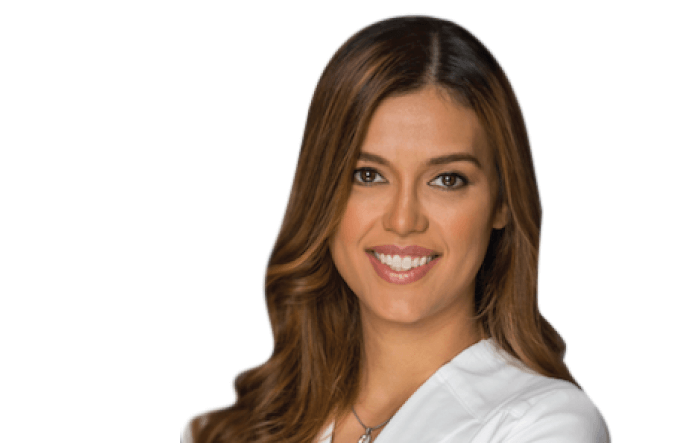
Cynthia Matossian, Founder and Medical Director of Matossian Eye Associates, Mercer County, New Jersey, and Bucks County, Pennsylvania, USA, who chaired and moderated the discussion.
Christophe Baudouin, Professor of Ophthalmology, chairing the department at Quinze-Vingts National Ophthalmology Hospital in Paris, France.
Alice T. Epitropoulos, Partner at Ophthalmic Surgeons & Consultants of Ohio, and a cofounder of The Eye Center of Columbus in Columbus, Ohio, USA.
Jennifer Loh, Founder of Loh Ophthalmology Associates in Coral Gables, Florida, USA.
Watch the full discussion here.
How do you explain dry eye disease (DED) to your patients, especially if they are asymptomatic?
Jennifer Loh: When I tell patients they have DED, they sometimes give me this incredulous look – especially when they have told me that they’ve been tearing and I explain that they suffer from dry eye. It takes time and patience to explain exactly what DED is, that it can be multifactorial, and that different people have different symptoms. Their eyes might not actually feel dry. I usually try to get beyond the barrier of the name – “dry eye disease” – and explain that, sometimes, there is a disconnect between what patients feel and what I see during their exams. Sometimes, they might not even feel the symptoms, but DED is responsible for the vision loss they have come to see me about. Once I establish the ground-level understanding, patients are much more accepting of further discussion and treatment.
Christophe Baudouin: Most of my patients complain of symptoms – except for those whose corneas have become anesthetized – but those symptoms can differ widely. Some complain of burning, others of discomfort; some will describe pain, although that is not common. Some patients also have feelings of fatigue. Studies have shown that the nature of complaints can also depend on the location and culture – and patients may use different words to describe the same symptoms.
One of my approaches has been to move from a simple description of symptoms to something more heterogeneous focusing on the consequences of dry eye related to quality of life. The Ocular Surface Disease Index (OSDI) can be helpful – I still use it. Questions are based around the intensity of symptoms, the type of symptoms, their frequency – whether they are acute-but-rare or mild-but-continuous – because quality of life may be impaired in the same way. Focusing more on consequences of symptoms – how it feels when driving or watching TV – can be useful.

Alice Epitropoulos: As Bill Trattler and colleagues from the PHACO Study Group described, visual complaints, such as reduced vision, can be more likely than typical symptoms of discomfort or foreign body sensation (1). Paying attention to patients’ complaints – for example, when they describe intermittent blurring of their vision when using a computer – is crucial.
Patients who are asymptomatic are sometimes the most challenging to treat, because they don’t realize they have DED. We can educate them by showing them their meibography and their abnormal tear osmolarity and explaining that this disease is progressive and chronic, and that it can start to affect their visual quality in a significant way.
Cynthia Matossian: I agree completely. Without our input and education, patients are unlikely to understand the condition, and therefore they won’t adhere to any of our recommendations.

What impact has the pandemic had on your patients? Has mask-wearing had an impact on DED?
Matossian: I recently published a study on the impact of continuous positive airway pressure (CPAP) devices and DED prevalence (2). Frequently, forced air escapes the mask seal. This, in turn, worsens the pre-existing ocular surface condition. From our extensive data review, we determined a definite correlation between CPAP use and DED. I’m proposing that there is a similar mechanism of air flow (almost like being in front of a fan) from the exhaled breath being forced directly upwards towards the eyes while wearing a mask. This stream of air escapes around the nasal bridge with direct impact on the tear film. We are eager to see study results on mask wear and DED.

Epitropoulos: With the aging population and the generally poor American diet, the prevalence of DED has been increasing anyway, but many of us feel that the COVID-19 pandemic is also contributing to the increase in prevalence of ocular surface disease. Many experts noticed the exacerbation of dry eye symptoms, along with increased chalazia and hordeola, during early lockdown. In fact, chalazion was the number one reason for the patient-initiated telehealth calls we received during the mandatory lockdown and I continue to see this in my clinic today. Many of my patients who had never had dry eye symptoms are now complaining of burning, irritation, tearing, and redness. Theoretical contributing factors may include increased digital device use, with people working from home and zooming more; masks result in an alteration of the mechanical airflow which as Matossian demonstrated in her study (2), may be contributing to increased ocular inflammation, tear film evaporation, and potential changes in the microbial flora of the ocular surface. Another variable that might be contributing to these phenomena is the mechanics of the blink while mask wearing, particularly that of the lower lid.
A group of us, including Cynthia and Jennifer, have developed a study design to prove this hypothesis of a pandemic-associated phenomenon with significant increases in the prevalence of DED, chalazia, and hordeola, but the obvious challenge to proving this hypothesis is the huge number of variables. It is difficult to get an accurate baseline for comparison and even more difficult to prove the methodology, but we are investigating it.
I actually looked at the diagnosis codes this year compared with the same period over the last two years, and noticed a 42 percent increase in dry eye codes and a 101 percent increase in chalazia and hordeola.
Loh: It’s amazing data. I have always had a very high population with chalazia in my dry eye practice, but now even more patients are coming in, and, as Alice said, most of the telehealth calls in 2020 were about chalazia. Patients who come in with this complaint sense that it’s due to mask use – they never used to suffer with these symptoms and it is really distressing for them. The psychological impact of not only dry eye, but also chalazion in particular, has been undervalued, in my opinion; these are some of the most upset patients we see.
I’m very excited to be part of this study and to have definite results, because I have seen a change. It could be a combination of things, but I would like to know why more of our patients are experiencing these symptoms.
Baudouin: It has been the same here in Paris. I recently saw good data that showed a clear difference in dry eye between people who wore masks for less than three hours a day, and those who wore them for more than six hours a day. Clearly, airflow plays a role, and it is further exacerbated by the compression of the mask and the increase in screen time. It all increases the rate of dry eye and aggravates existing conditions.
Defining DED is not easy; in fact, it has been the subject of major debate. It really depends on the way we understand dry eye. It can be seen as a multifactorial disease in which hyperosmolarity, inflammation, and nerves all play a role. Another definition points to the fact that it’s an imbalance or impairment of normal homeostasis – so dry eye would not be a disease of the tears, but a disease of the way in which the eye is protected against the environment. According to this definition, the loss of normal homeostasis could be the core definition of dry eye.
Why is it important to diagnose and treat ocular surface disease (OSD) and DED?
Loh: Without treating dry eye, we’re not helping our patients get the best possible visual results, whether it be with glasses, contact lenses, or cataract or refractive surgery. We know that these results rely on the health and stability of the ocular surface. As ophthalmologists, when we’re helping our patients see better, we have to treat the underlying cause – and one of the most common reasons for blurred vision is dry eye.
It is a lifetime care for the eye. Many patients who come in for routine exams ask how to best take care of their eyes. I tell them that the best thing to do is take care of their ocular surface. Just as dentists have done a phenomenal job educating the public on the concept of dental hygiene from birth, I believe that we must do the same for our patients with regard to the need for appropriate ocular hygiene. When I see elderly patients with terrible gland and ocular surface disease, I feel that one of my purposes in life is to educate patients about this. These changes don’t happen overnight, so early prevention can really make a big change.
Baudouin: Quality of life complaints are the main reason patients come to see us, but vision is also very important. If the quality of the tear film is poor, then the quality of vision and visual results after cataract procedures will be impaired – and we know that one of our patients’ most frequent complaints is dissatisfaction after refractive surgery. I have also seen many patients with severe meibomian gland disease (MGD) who don’t complain a lot (or, sometimes, at all), but who are at risk of developing DED after cataract surgery. It is important to diagnose this early to avoid complaints after surgery.
Epitropoulos: In my opinion, there are three compelling reasons why correctly diagnosing and treating DED is important. First, we know that the tear film is the most important refractive surface of the eye; an unstable tear film can result in inaccurate biometry and keratometry readings, which can give suboptimal refractive outcomes (3). All the technologies we have available today – advanced femtosecond lasers, wavefront aberrometry, toric/premium MFIOL lenses – have higher failure rates in patients with compromised ocular surfaces.
Second, cataract surgery is likely to induce or exacerbate pre-existing DED in a high percentage of patients. If surgery doesn’t live up to their expectations, patients are much more likely to blame their surgeon than pre-existing DED – that’s why it’s critical to diagnose and treat it prior to surgery.
Lastly, treating lid disease and blepharitis to eliminate bacterial overgrowth helps reduce the risk of endophthalmitis postoperatively. Again, if left untreated, DED can have an impact, not only on vision and comfort, but also on long-term ocular health and surgical outcomes.
Matossian: I tell my cataract patients that they have two issues: one is the cataract, and once it’s removed, they will never grow another one; the second problem is lifelong, chronic, and progressive – their DED/MGD. I always use words like “forever” or “there is no cure,” to emphasize that, even when their cataracts are gone, dry eye requires lifelong management.
How do you work up your DED patients?
Baudouin: At my practice, we are lucky to have almost everything that is available in terms of technological solutions. For me, the most appropriate tool is the In vivo confocal microscope, which I have been using for almost 20 years. In my opinion, just a single drop of fluorescein is also extremely efficient for getting a lot of information about the cornea, conjunctiva, and tear film to observe the way in which instability occurs. I might be biased, though, because most of my patients are referred for very severe DED.
Epitropoulos: If patients are symptomatic (using the SPEED questionnaire), I empower my technicians to proceed with testing prior to my seeing them, which really improves workflow and helps diagnose patients quickly. My team uses InflammaDry, which detects MMP-9, an inflammatory marker elevated in the tears of dry eye patients. We also obtain tear osmolarity to help determine the severity of the condition and therapeutic response. Meibography has been a game-changer for me when it comes to diagnosing, treating, and educating patients about MGD. I see it as an extremely important screening tool, considering 86 percent of dry eye patients have a component of MGD. It really helps to identify DED before there’s irreversible damage to the meibomian glands. Recently, I have also trained my technicians to evaluate tear breakup time and corneal staining. I used to do it myself, but we have been trying to further improve workflow efficiency and minimize the amount of time patients spend in the office.
Loh: We always like to start by taking a detailed patient history; we often use a questionnaire, such as the Speed or the OSDI questionnaires. I like to use fluorescein strips because I think they help better evaluate tear breakup time. I use meibography when needed but, before that (and after evaluating the cornea and conjunctiva), I focus on the lids and lashes. I look at signs of blepharitis and collarettes – possible Demodex. This is something every ophthalmologist can do at the slit lamp. I also look specifically at the meibomian gland orifices, and gently press on the lid margin with a cotton tip applicator. You can see if the meibum is clear and flowing; unfortunately, I often see a capped gland with thick, toothpaste-like oil secretion coming out. I feel like this exam yields a lot of information and can guide me down the correct diagnosis path.
Matossian: We have cut our questionnaire down to three questions – we don’t go through the formal OSDI or Speed questionnaires to minimize the time patients spend in the office. My technicians are trained to ask our patients: “Do your eyes feel tired?” “Does your vision change throughout the day?” (We previously asked “Does your vision fluctuate throughout the day?” and found that some patients didn’t know what the word fluctuate meant and were embarrassed to ask. A simple word change can make a huge difference!). Our third question is “How many times a day do you use artificial tears?” We ask specifically about how many times a day, not just whether or not they use artificial tears, because the frequency of use is indicative of the patient’s level of discomfort. We also do MMP-9 testing, meibography, and tear osmolarity. When I enter the exam room, all the test results are available. I use lissamine green and fluorescein with my slit lamp exam; each dye tells me something different. I also look at the lid margin and conjunctiva using the new ASCRS recommendations to look, lift, pull, push.
In an ophthalmologist’s office, time is of the essence. How much more time do you spend with a patient when performing a DED protocol?
Loh: Trying to do too much can really lead you down the rabbit hole – every test adds time. In my setting, I see more general patients initially, not just severe DED cases, so I don’t do all the available tests straight away. Where I have been able to streamline care is after making the diagnosis; I used to discuss every possible treatment and dry eye theory with patients, which took a lot of time and often left them overwhelmed. These days, I stick to a brief description to make sure they understand the problem and start with my preferred initial treatment if they are happy with it. I have found it works better than explaining every possibility at the start.
Baudouin: Indeed, the protocol is time-consuming. I do the slit lamp exam with staining myself, because I sometimes find a hint of something that a technician may have missed, which I address at the end of the exam. It’s crucial that the whole protocol is done at the first visit and a detailed history is taken. The first visit is like a police investigation in my clinic! One good question can give you an instant answer to a problem, such as a history of allergy or present or past systemic medication. Also, you can identify some conditions, like rosacea, just by looking at the patient’s face. Even though the first examination with the series of questions may take five to 10 minutes, it can solve the patient’s problem and avoid the need for subsequent visits, improving the patient’s mental health and quality of life.
Epitropoulos: In a busy practice, patients represent both an opportunity and a challenge. The opportunity is providing better, life-enhancing care, but the challenge is that it takes time. Understanding patients, diagnosing them correctly, and educating them on available treatment options can really keep doctors and staff on schedule. We recently implemented a new software system, MD Backline, that automates patient communication and history collection. It has been a game-changer for our practice and our dry eye protocol – it makes the process more efficient, patient histories more accurate, and our use of advanced therapies more widely accepted because patients are aware of these solutions before they even come into the office. It allows us to focus on diagnostic testing and educating patients when they make it into the office.
Matossian: Bidirectional communication with a patient ahead of their visit through a platform like MD Backline really helps – patients have the time, in the comfort of their homes, to fully answer all the questions. By incorporating their responses into the EMR, we shorten the patients’ time in the office.
Where do you start with DED treatment?
Loh: It depends on how advanced the disease is and how much other treatment they have had, but I will focus on the newly diagnosed mild DED patients who have never been on any type of treatment, including artificial tears. If I find MGD, I start with a course of lubrication, warm compresses, and possibly cleansing solutions for the lids and lashes to get a baseline. This process is easy and cost-effective for patients and doesn’t seem intimidating.
If the condition is more exacerbated and patients are in more acute distress, I often add a prescription medication. Usually, it’s a corticosteroid to begin with, followed by basic lid hygiene and lubrication with artificial tears. I talk to patients about environmental factors, explain that it is a chronic condition, and ask them not to expect to get better in a couple of days. I make sure they understand that it’s a team effort and we have to work together. If I decide to use a corticosteroid drop, I check back a few weeks later and follow their IOP. Then I move the patients on to the next stage, such as thermal therapy or a prescription medication drop.
Baudouin: My approach is very similar, but I need to emphasize two ideas. The first is to collect all possible information about the previous treatment. Some patients come in with, for example, preserved eye drops. They tend to put more drops in when their eyes feel dry, and the more drops with preservatives they use, the worse their DED gets.
My other important point is to make sure where the disease comes from; whether it’s tear deficiency, most likely associated with corneal damage, or from the eyelid. In the first case, I propose artificial tears or gels or steroid pulses or topical cyclosporine. In the second, where it is most likely tear instability, I focus more on the lid hygiene; in severe cases, such as rosacea, I use specific therapeutic strategies to decrease inflammation.
With regard to artificial tears, some patients prefer liquid artificial tears and others are more comfortable with gels; we must consider their preferences.
Epitropoulos: It’s important to establish that patients don’t have any other pre-existing conditions such as anterior membrane dystrophy, irregular astigmatism or macular pathology. My threshold for starting patients on an immune modulator is very low, because we know most DED patients have some inflammation. We also know that MGD is the most common type of dry eye disease, and it’s important to treat this early, before gland loss limits the effectiveness of the treatment. There are several exciting options for treating MGD these days: thermal pulsation, iLux, TearCare, and others.
Matossian: I believe in layering or stacking treatments by using a mixture of in-office procedures, prescription medications, and at-home remedies to address each patient’s unique dry eye needs.
What in-office procedures do you offer your DED patients?
Loh: If this is a new diagnosis and I notice issues such as MGD or blepharitis, I start patients with home remedies and then offer a treatment called Blephex, which is micro-buffer exfoliation of the lids and lashes. I also perform thermal pulsation (such as LipiFlow) and TearCare; both procedures specifically target the meibomian gland to treat the evaporative component. If patients note an improvement, it is easier to then offer them other options, as the cost of these procedures is covered by the patient. Patients have to believe in these procedures, so I explain I’ve seen the difference they make firsthand and I think it’s of great value to them.
Epitropoulos: We schedule in-office procedures on dedicated days. I typically do thermal pulsation combined with a Blephex treatment, followed by expression. I then give patients a maintenance program which extends the therapeutic benefit of the procedure. Furthermore, home treatments work better once the meibomian glands are unobstructed and functioning, so even if hot compresses didn’t previously work, they might be more helpful after the in-office treatment. I advise blinking exercises, hot compresses, lid scrubs using hypochlorous acid, omega 3 fatty acids, and preservative-free artificial tears and gels at night. An overwhelming majority of patients notice an improvement when they follow these steps.
Matossian: Yes, the key is to let patients know that they have to continue doing all recommended treatments: using their heated masks at night, taking oral omega 3 supplements, using artificial tears, and doing lid hygiene. I also agree with the need to bring the patients back once they’ve seen improvement. Additional complimentary procedures can be incorporated as warranted.
Baudouin: I have been focusing on intense pulsed light (IPL) therapy, which seems to give really interesting results.
Matossian: Indeed, I am hoping to do a study combining IPL therapy with thermal pulsation. The mechanisms of action are different – one heats and evacuates; the other treats inflammation in the periocular lymphatic and vascular systems.
What new technologies excite you?
Baudouin: Let me start from the beginning: the first magic moment in my career was removing the preservatives from therapy. It solved almost 50 percent of my patients’ problems! That’s how I got a reputation for being good with DED. I was just stopping part of the treatment; honestly, it wasn’t as clever as I was given credit for, but it worked wonders.
The second magic moment was when we started using cyclosporine (in Europe, this was the late 1990s). I was facing patients for whom nothing worked, despite their trying many different tear substitutes. When I started using cyclosporine, I was able to give 50 percent of patients relief and noticed some improvement in a further 25 percent.
I got the same feeling when I discovered that doxycycline improved patient outcomes. It was reserved for patients with severe disease, but really improved their condition. These days, I’m excited about the warming devices I mentioned.
Loh: I don’t have personal experience with IPL, so I’m really interested in Christophe’s and Cynthia’s perspectives. I see a lot of potential in that area. There’s also a treatment similar to IPL – an easier point-of-care test – that I have heard good things about.
Epitropoulos: We are enrolling patients in a study looking into a proprietary, preservative-free solution that may help patients with meibomian gland secretions.
Matossian: Many technologies are coming down the pipeline – new compounds for Dry eye drops; a treatment for Demodex… I’m also looking forward to trying a nasal spray that is designed to stimulate tear stimulation.
We are very fortunate to have many options available to us now and around the corner, however, the patients are the real beneficiaries! Seven or eight years ago, these options weren’t available at all. It’s great that we can share and compare our knowledge and disseminate this to other professionals to help every patient suffering from dry eye disease.

References
- WB Trattler et al., “The Prospective Health Assessment of Cataract Patients’ Ocular Surface (PHACO) study: the effect of dry eye,” Clin Ophthalmol, 11, 1423 (2017). PMID: 28848324.
- C Matossian et al., “The prevalence and incidence of dry eye disease among patients using continuous positive airway pressure or other nasal mask therapy devices to treat sleep apnea,” Clin Ophthalmol, 14, 3371 (2020). PMID: 33116388.
- AT Epitropoulos et al., “Effect of tear osmolarity on repeatability of keratometry for cataract surgery planning,” J Cataract Refract Surg, 41, 1672 (2015). PMID: 26432124.
